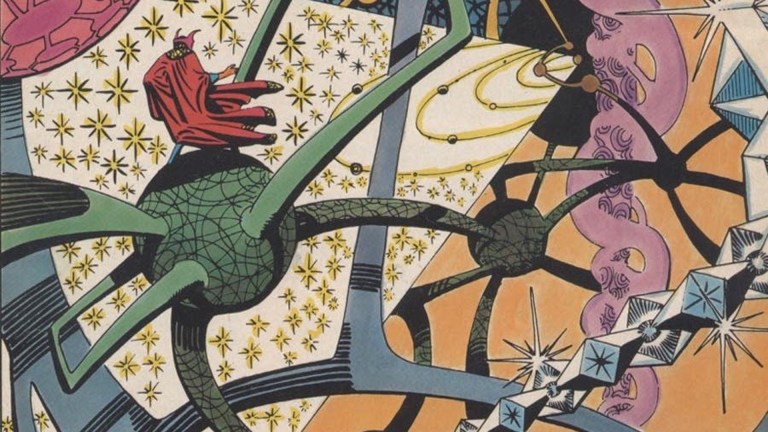The Doctor Strange and Pink Floyd Connection
Marvel's Doctor Strange has a weird history with psychedelic rock band Pink Floyd. Get ready to expand your mind.

Doctor Strange and Pink Floyd both got their start during the 1960s, a decade known for mind-expansion, psychedelic experimentation, and the pushing of cultural and artistic boundaries. Neither were exactly in step with the rest of their genre.
Doctor Strange, unlike his spandex clad and heavily muscled contemporaries, used occult practices like black magic and astral projection to defeat his foes instead of brute force. Pink Floyd were never really the kind of post-Beatles psychedelic pop group that were still common in the late ’60s, nor were they ever the kind of blues-based hard rock or technically-oriented progressive rock band that dominated the 1970s. Unsurprisingly, Doctor Strange comics were popular on college campuses as the counterculture revolution of the 1960s began to take hold and it’s easy to see stoners disappearing into Steve Ditko’s surreal artwork while early Floyd records played or why psychedelic rockers were more drawn to these than traditional superhero fare.
Doctor Strange director Scott Derrickson dropped a number of Pink Floyd references on Twitter during the production of the Doctor Strange movie (not to mention Bob Dylan, The Talking Heads, T.Rex, and other bands), so I was waiting to see if a Pink Floyd song would actually make its way into a Marvel movie.
I wasn’t disappointed.
Pink Floyd’s “Interstellar Overdrive” plays during a key early sequence in the movie. It comes from first Pink Floyd album, The Piper At The Gates of Dawn, which abandoned the melodic but skewed psychedelic pop of their early singles, “Arnold Layne” and “See Emily Play” for a collection of songs that were more metaphysical, sinister, and occasionally (like in the case of “Interstellar Overdrive”) freeform explorations of sound and feedback. The album version clocks in at nearly 10 minutes, but live versions could run longer, as long as the band wanted, really, and were accompanied by a psychedelic light show and oil projections that were conducive to mind-expansion. Those visuals wouldn’t have looked out of place in the Doctor Strange comics of the era, either.
Pink Floyd’s guitar player, singer, and driving creative force in 1967 was Syd Barrett, who left the group the following year due to worsening mental illness that was likely accelerated by his voracious appetite for mind-altering chemicals like LSD. Marvel’s Doctor Strange movie certainly leans heavily on imagery consistent with the visuals associated with LSD, psilocybin, and mescaline trips (Strange even accuses the Ancient One of spiking his tea with psilocybin), which is fitting, even if it isn’t a direct connection to Pink Floyd.
Barrett was still present on a few tracks on the band’s second album, 1968’s A Saucerful of Secrets, which has a semi-hidden image of Doctor Strange on the cover. The collage effect is not only reminiscent of the band’s light shows and a representation of the psychedelic experience, but the placement of Strange himself makes it look as if the whole album cover is a spell being cast by the Master of the Mystic Arts.
The Strange elements come from a story in 1967’s Strange Tales #158, with art by Marie Severin (Doctor Strange co-creator Steve Ditko had left Marvel almost a year earlier).
Here’s the page:
(and thanks to Richie who pointed out the specific issue in the comments of our article about all of the easter eggs in the Doctor Strange movie)
The title track, “A Saucerful of Secrets” is kind of like the sequel to “Interstellar Overdrive” as it’s another extended instrumental that places more emphasis on experimental sound than it does on anything resembling a traditional rock song structure. In other words, it’s the perfect accompaniment to your reading of weird-ass Doctor Strange comics from the era.
What I somehow never realized until this NightFlight article pointed it out to me is that you can also spot Marvel cosmic entity The Living Tribunal in the upper left-hand corner of the album cover, too…
Doctor Strange was still on the band’s radar enough that they included him in the lyrics of “Cymbaline” from their third album, 1969’s soundtrack to the Barbet Schroeder film, More. “Suddenly it strikes you, that they’re moving into range,” Syd Barrett’s replacement David Gilmour intones solemnly, “and Doctor Strange is always changing size.”
Funny enough, “Cymbaline” was known as “Nightmare” when it was performed as part of The Man and The Journey suite of songs, meaning it shared a name with the first villain Strange ever fought in the comics. Soon the band’s lyrical focus drifted away from metaphysical concerns and into more earthly ones, and while they continued to produce extended musical compositions, the atonal sounds of “Interstellar Overdrive” and “A Saucerful of Secrets” gave way to the more melodic “Echoes” and “Shine On You Crazy Diamond.”
But if Doctor Strange was an influence on the band in their early days, you can perhaps see hints of Pink Floyd’s influence on the character in the 1978 Dr. Strange TV movie, which has a synth-heavy, at times funky, electronic soundtrack and an astral trip visual sequence that looks like some of the light show projections the band were known for. The final song on Michael Giacchino’s Doctor Strange score, “Master of the Mystic Arts” subtly evokes some of the band’s 1970s work, too.
But one final piece of Doctor Strange/Pink Floyd synchronicity popped up in 2016. Doctor Strange star Benedict Cumberbatch joined former Pink Floyd guitarist David Gilmour on stage to sing “Comfortably Numb,” a song which started life as a demo called, funny enough, “The Doctor.” Whether this is coincidence, or simply the universe bringing the Pink Floyd/Doctor Strange connections full circle is entirely up to you to decide, of course. Maybe Doctor Strange 2 can find room for more Pink Floyd music when exploring the Dark Dimension or somewhere similar.
